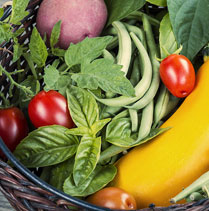
SuperKids Nutrition caught up with nutrition expert Gita Patel, RD, CDE to hear how her culture rich childhood influenced her diet and how to cook healthfully with a busy schedule.
How can parents protect their children against the growing occurrence of childhood obesity?
Grow, cook and eat meals together as a family. Growing food together is such an important step in protecting your children against obesity. My children helped in the family garden and would pick, wash and eat raw vegetables right from the garden. They didn’t know if it had to be cooked or not. I’m proud to say both of my grown children have their own gardens today. My son lives in New York City and grows lettuce and different greens. His windows are filled with herbs! You don’t need a land plot to have a garden! Here are some great tips for starting a kid-friendly garden with your family.
Can you recommend any of your favorite family meals?
Since I’m from India, I cooked Indian food while my children were growing up, so that they could learn about the culture. One of the dishes was rice and beans cooked together with a sauce made with yogurt and chickpea flour. I served it with a green vegetable, such as spinach or any green leafy veggie as well as a salad made with cucumbers and cabbage, seasoned with cumin, salt, cilantro, and hot chilies. The kids loved it!
Do you have any tips for fitting cooking into a busy schedule?
Organization and planning are key! Have a plan in place. Use the weekends to plan the menu for the week. Shop according to what you are going to cook. Beans or grains are going to take time. Cook these staples for more than one meal then freeze the rest. Keep your fridge stocked. Also on the weekends, make sure you prepare one or two dishes for the week that are going to take time. Another idea is to delegate a chore to every family member to do the night before that involves getting something ready for the next day’s meal. Also, keep in mind that meals don’t have to be fancy. It’s OK to keep things simple! Here are our 6 Tips to Make Meal Planning Easier.
It is also very important to keep healthy, unprocessed and unpackaged foods around, lots of vegetables and fruits, and nuts and beans.
A few more tips:
- Limit high sugar and high fat containing foods and beverages.
- Discourage mindless eating in front of the TV.
- Limit sedentary activity in front of the TV and computer.
- Encourage playing outdoors, taking family walks and physical activity such as playing outdoor games together as a family.
Lately the word “plant-based meals” is heard more often in the media. What does this mean? How can meat lovers incorporate a couple of these meals into their families’ diets?
Plant-based meals include foods prepared from the following categories: beans and legumes, grains, vegetables, fruits, nuts and seeds, herbs and spices. Basically, anything that does not walk or swim. Meat lovers can enjoy more of these foods in all of their meals and snacks and can also enjoy several meatless meals (or entire days) each week.
For someone who includes meat in almost every meal do you have any “first steps” they can take to explore plant-based options?
Turn your favorite meals into plant-based meals.
- Add beans to a salad.
- Have some pasta with meatless sauce!
- For chili, don’t add meat, use beans instead!
- If you love Mexican food, add beans instead of meat.
- When eating Chinese food try tofu and veggies.
- For Indian food, always choose beans and/ or veggies. So many options available!
- Throw veggies on your pizza instead of meat toppings.
- Have a veggie patty instead of a hamburger.
Favorite foods can be changed into plant-based meals a couple times a week. Making this small switch can cut down on prep time and clean up.
What is your definition of moderation?
“Moderation within variety and balance.” Focus on your whole week of eating. If you include a variety of vegetables throughout the week (green leafy veggies, root veggies such as beets, potatoes) and say you regularly have some fruit for dessert, occasional ice cream can fit into a diet that is full of healthy food choices.
Could you describe two creative ways families can involve their kids in the kitchen?
Start early when they are young and let them have fun. Making bread, pancakes, pretzels are easy and my children loved to make the dough and different shapes. Helping wash the salad ingredients and playing in the water was also an enjoyable experience for my children. They always ended up eating the lettuce and vegetables as they were rinsing the vegetables. Here are some more easy ways to include kids in the kitchen.
If there was one message you could communicate to parents about raising healthy eaters, what would it be?
Practice what you want your children to do. Set a good example. Enjoy eating a variety of healthy foods, meals, and snacks. Children learn from example and eating habits are formed early in life.
____
Gita Patel MS RD CDE LD, partners with individuals and organizations who desire the science of nutrition translated into a healthy vegetarian lifestyle. She was raised in a traditional vegetarian family in India and her first experience with food involved health and medicine. She has taught nutrition through vegetarian Indian cooking in a variety of venues including television. She is a Certified Diabetes Educator providing healthy solutions for people with diabetes. www.feedinghealth.com
You can view all of our nutrition and health expert interviews for everyday tips to healthy living.












